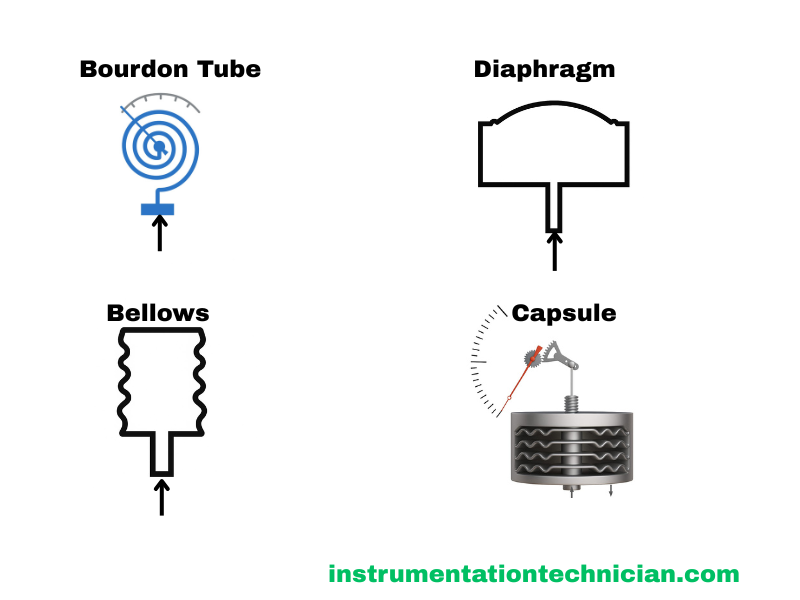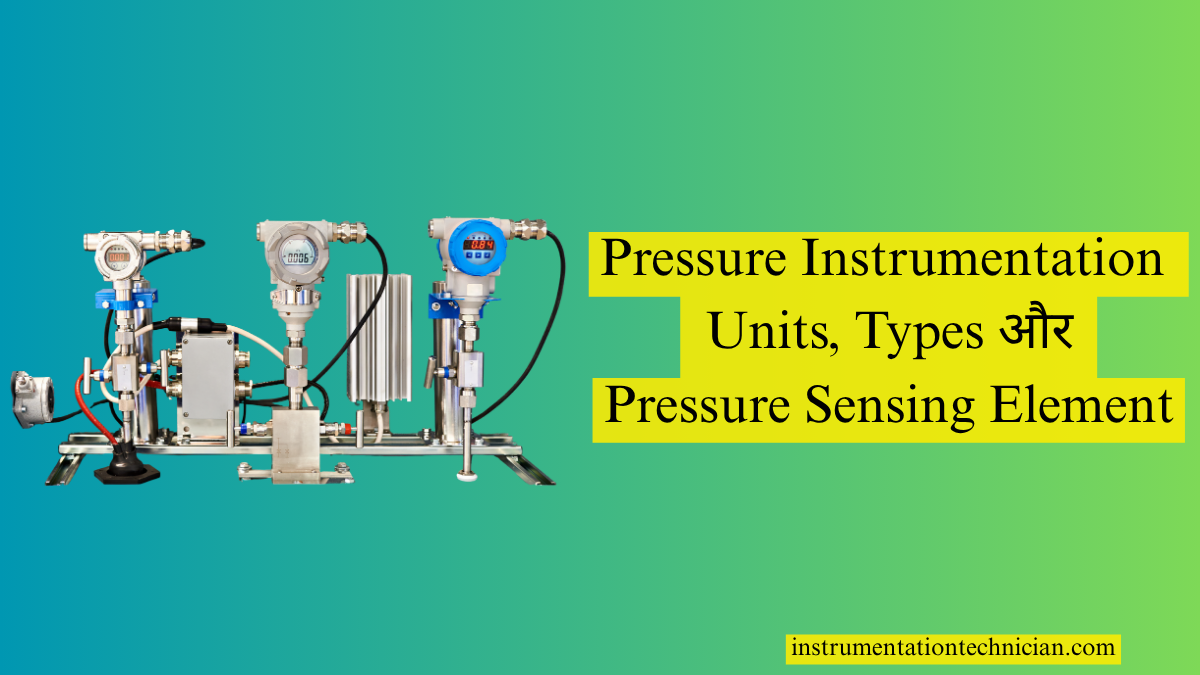Pressure Instrumentation field का base है, और किसी भी industrial plant की heart line कह सकते हैं। चाहे power plant हो, oil refinery या chemical factory – हर जगह pressure को monitor करना जरूरी होता है ताकि system safe और efficient रहे।
Example: मान लो एक boiler में steam बन रही है। अगर pressure ज़्यादा हो गया तो boiler blast भी कर सकता है! इसलिए वहाँ pressure transmitter लगाया जाता है जो continuously pressure monitor करता है और control room को signal देता है – ताकि safety बनी रहे।
What is Pressure?
Pressure का मतलब होता है — “Force जो किसी surface पर डाली जाती है per unit area.
इसका formula है:
P = F / A
जहां,
P = Pressure
F = Force
A = Area
एक example से समझते है:
मान लो आपने एक छोटा सा पत्थर हाथ में लिया और उसे मिट्टी पर रखा — कुछ खास फर्क नहीं पड़ेगा।
लेकिन वही force अगर एक नुकीली कील के ज़रिए डालो तो वो ज़मीन में घुस जाएगी।
क्यों?
क्योंकि कील का contact area बहुत छोटा है, जिससे Pressure ज्यादा बनता है।
Field Example – Boiler:
Boiler के अंदर steam बनती है और उसकी वजह से pressure generate होता है।
अगर steam ज़्यादा बन गई, तो pressure भी बढ़ेगा।
अब ये pressure पूरे boiler की internal surface पर बराबर force डालता है।
Example के तौर पर,
अगर boiler के अंदर 1000 Newton force लग रही है और उसका अंदरूनी surface area 2 m² है,
तो pressure होगा:
P = F / A = 1000 / 2 = 500 Pascal
मतलब boiler के अंदर 500 Pascal का pressure बन रहा है।
अगर यही बढ़कर 2000 Newton हो जाए, तो pressure भी double हो जाएगा। इसलिए pressure instrumentation जरूरी है।
Units of Pressure
Unit मतलब measuring का तरीका — जैसे हम distance को meter में measure करते हैं, वैसे ही pressure को bar, psi, kg/cm² जैसे units में measure जाता है।
Common Pressure Units
- kg/cm²
- bar
- psi (Pound per square inch)
- Pa (Pascal)
- mmH₂O
- mmHg
- inH₂O –
- inHg –
Pressure Units Conversion Table (With Use Cases)
जब भी हम किसी pipeline, vessel, या tank में pressure measure हैं, तो हमें अलग-अलग units मिलती हैं। अब कौन सी unit कहाँ use होती है, और उसका दूसरा unit में conversion क्या होगा — ये जानना एक instrumentation technician के लिए बहुत जरूरी है।
चलो एक table के ज़रिए समझते हैं:
| 🔹 Unit Name | 🔁 Conversion | ⚙️ Use Case | 🏭 Refinery Example |
|---|---|---|---|
| kg/cm² | 1 kg/cm² = 0.9807 bar | Process line या high pressure vessel के लिए | Reactor vessel का pressure 4 kg/cm² |
| bar | 1 bar = 14.5 psi | Most common industrial unit | Pump discharge pressure 7 bar |
| psi | 1 psi = 0.06895 bar | Gulf या American plants में use होता है | Compressor outlet = 100 psi |
| Pa (Pascal) | 100,000 Pa = 1 bar | Scientific या ultra-low-pressure systems | Control valve actuator pressure = 250,000 Pa |
| mmHg (Torr) | 760 mmHg = 1 atm = 1.013 bar | Vacuum system या pharma plants | Vacuum distillation system = 50 mmHg |
| inHg | 1 inHg = 33.86 mbar | HVAC और condenser systems मैं | Condenser vacuum = 25 inHg |
| mmH₂O | 1 mmH₂O = 0.000098 bar | Low pressure line या DP measurement के लिए | Filter ke across DP = 100 mmH₂O |
Types of Pressure
जब भी हम किसी भी pipeline, vessel, या system का pressure measure करते हैं, तो वो pressure अलग-अलग तरीके से define किया जाता है। हर एक application में अलग-अलग type of pressure use होता है — जैसे कभी हमें atmosphere के comparison में pressure देखना होता है, कभी बिल्कुल vacuum से।
Instrumentation field में 4 main pressure types होते हैं:
- Atmospheric Pressure
- Gauge Pressure
- Absolute Pressure
- Vacuum Pressure
अब नीचे हम इन चारों pressure types को step-by-step समझेंगे
1. Atmospheric Pressure
Atmospheric pressure वो दबाव होता है जो air हमारे चारों तरफ हर वक्त बनाती है। हम जब सांस लेते हैं, चलते हैं या कोई काम करते हैं — तो ये pressure हमेशा हमारे ऊपर होता है। Sea level पर इसका average value होता है 1 atm (atmosphere) या 101.325 kPa.
Example के लिए सोचो कि एक open water tank है, उसमें ऊपर से हवा का जो दबाव पड़ रहा है, वही है atmospheric pressure. ये pressure instruments में तब important होता है जब हम absolute pressure measure करते हैं, क्योंकि absolute में atmosphere भी count होता है।
Instrumentation में यह base reference की तरह काम करता है।
2. Gauge Pressure
Gauge Pressure वो pressure होता है जो atmospheric pressure के ऊपर का pressure दिखाता है। मतलब अगर किसी vessel में pressure बढ़ रहा है, तो वो कितना ज़्यादा है atmosphere से — यही PG (Pressure Gauge) दिखाता है।
PG हमेशा atmosphere को zero मानकर reading देता है। जैसे अगर एक pipeline में pressure 2 bar है, तो इसका मतलब 2 bar above atmosphere है।
Industrial plants में PG इसलिए use होता है क्योंकि हमें अक्सर ये जानना होता है कि system में normal से कितना ज़्यादा pressure है।
Example: Boiler में अगर PG 5 bar दिखा रहा है, तो actual pressure है 5 bar gauge — absolute थोड़ा ज़्यादा होगा।
3. Absolute Pressure
Absolute Pressure वो होता है जिसमें atmospheric pressure + gauge pressure दोनों शामिल होते हैं। ये total pressure होता है, यानी zero reference point vacuum होता है।
जैसे मान लो gauge pressure 2 bar है और atmospheric pressure 1 bar है, तो absolute pressure = 2 + 1 = 3 barA (bar absolute)।
Absolute pressure ज़्यादातर scientific calculations और vacuum systems में use होता है जहाँ accurate total pressure जानना जरूरी होता है।
Example: अगर किसी sealed vessel में vacuum maintain करना है, तो हम absolute pressure में ही reading लेते हैं — ताकि ये पता चले कि system बिल्कुल खाली है या नहीं।
4. Vacuum Pressure
Vacuum Pressure का मतलब होता है ऐसा pressure जो atmosphere से कम होता है। इसे हम negative pressure भी बोलते हैं, क्योंकि ये gauge scale पर zero से नीचे चला जाता है।
अगर atmosphere pressure 1 bar है और किसी vessel के अंदर pressure 0.3 bar है, तो vacuum pressure = 1 – 0.3 = 0.7 bar vacuum कहलाएगा।
Vacuum systems, suction pumps, और chemical processing जैसे areas में ये बहुत common है।
Example: Refinery में जब किसी line या tank से gas evacuate करते हैं, तब वहाँ vacuum create किया जाता है ताकि contamination न हो।
Pressure Sensing Elements
जब भी हमें किसी पाइपलाइन, टैंक या vessel के अंदर का pressure measure करना होता है, तो sensor के अंदर एक ऐसा part होता है जो उस pressure को “feel” कर सके — उसी part को कहते हैं Sensing Element.
यह element जैसे ही pressure को sense करता है, यह अपनी shape बदलता है (जैसे मुड़ना, झुकना या फैलना), और उसी shape change के हिसाब से transmitter या gauge reading दिखाता है।
Pressure Sensing Elements
1. Bourdon Tube
2. Diaphragm
3. Bellows
4. Capsule
नीचे दिए गए image में 4 main elements दिखाए गए हैं — अब एक-एक करके Bourdon Tube, Diaphragm, Bellow और Capsule को step by step समझते हैं।

1. Bourdon Tube
Bourdon Tube एक mechanical pressure sensing element होता है जो pressure increase होने पर bend (मुड) जाता है. इसका shape generally C-type या helical होता है. जब internal pressure बढ़ता है, tube expand होती है और इसका movement pointer को move करता है, जिससे reading मिलती है.
कहां use होता है:
Bourdon tube mainly pressure gauges में use होती है, जहाँ medium से high pressure measure करना होता है — जैसे steam lines, oil refineries, compressors और hydraulic systems में.
👉 Bourdon Tube क्या होता है? जानिए Working Principle,और Types
2. Diaphragm
Diaphragm एक thin, flexible metal sheet होती है जो pressure sensing के लिए use होती है. Jab pressure पड़ता है तो यह sheet slightly deflect करती है और sensor signal generate करता है.
कहां use होता है:
Diaphragm sensors mostly sanitary applications जैसे pharmaceutical, food, aur dairy plants में use होते हैं. Lekin refinery में ये corrosive fluids या sludge वाले line में use किए जाते हैं जहाँ bourdon tube fail हो सकती है.
👉Diaphragm क्या होता है? जानिए Working Principle और Types
3. Bellows
Bellows एक accordion type flexible structure होता हैजो pressure sensing के लिए use किया जाता है. Jab pressure apply होता है, bellows expand या contract करता है, और यह movement mechanical pointer या electrical output में बदला जाता है.
कहां use होता है:
Bellows sensors mainly lower pressure range (vacuum या low gauge pressure) applications में use होते हैं. Yeh clean gases और non-corrosive fluids के लिए suitable होते हैं — जैसे HVAC systems, leak testing units, aur light-duty process panels में.
👉Bellows क्या होता है? जानिए Working Principle,और Types
4. Capsule
Capsule एकpressure sensing element होता है जो दो diaphragm को जोड़कर बनाया जाता है. दोनों diaphragm के बीच enclosed space होता है, जो pressure change पर expand या compress होता है इस movement से pressure measure होता है.
कहां use होता है:
Capsule sensors खासकर gas और low pressure measurement के लिए use होते हैं. यह mainly air pressure gauges, clean gas lines, और lab instruments में लगाए जाते हैं जहाँ high accuracy चाहिए but pressure low होता है.
👉Capsule क्या होता है? जानिए Working Principle,और Types
FAQs: Pressure Sensing Elements
What are Pressure Sensing Elements?
Pressure sensing elements वो mechanical parts होते हैं जो किसी system का pressure feel करते हैं और उसे movement या deformation में convert करते हैं। फिर वही movement transmitter या gauge के ज़रिए readable signal में बदल दिया जाता है। Example: bourdon tube, diaphragm, bellows, capsule.
What materials are used in pressure sensing?
Pressure sensing elements ज़्यादातर stainless steel, brass, या phosphor bronze जैसे materials से बनाए जाते हैं।
Agar corrosive fluid हो (जैसे acid या chemical), तो Hastelloy, Monel, या Tantalum coating use किया जाता है — ताकि material खराब न हो।
What are the types of pressure sensors?
Pressure sensors के 3 main types होते हैं:
Strain Gauge Type (Electrical signal में convert करता है)
Capacitive Type (Diaphragm के movement से capacitance change होता है)
Piezoelectric Type (Quick pressure change के लिए – जैसे vibration या impact)
How to sense pressure?
Pressure को sense करने के लिए सबसे पहले pressure sensing element use किया जाता है।
वो element जैसे ही pressure feel करता है, वो अपनी shape change करता है – और वही shape change transmitter या sensor electrical signal में बदल देता है। फिर वो signal control room तक जाता है, जहाँ reading display होती है।
अगर आपको अभी भी Pressure Sensing Elements या Instrumentation से जुड़ा कोई भी doubt है, तो नीचे comment जरूर करें! आपका सवाल किसी और के लिए भी helpful हो सकता है.

1 thought on “Pressure Instrumentation क्या होता है? Units, Types और Pressure Sensing Element”